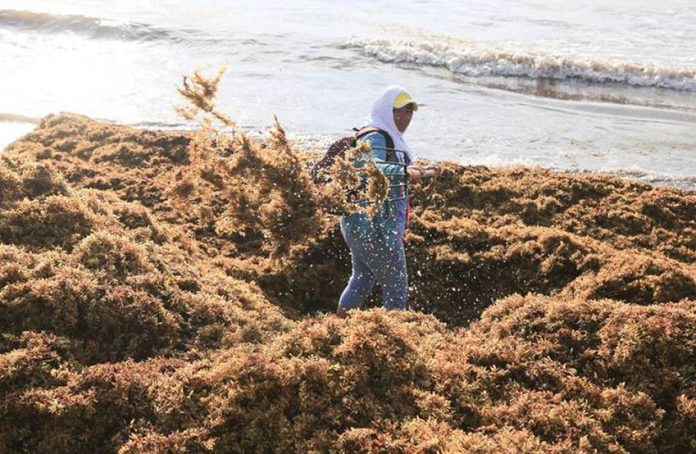The government of Quintana Roo is installing a system of containment booms to keep sargassum off the beaches.
But any proposal to address the invasion of the seaweed can’t come too soon: much more is on the way, a researcher warns.
The state will place offshore floating barriers — much like those used to contain oil spills — to prevent the sargassum from collecting on beaches, where it piles up in a stinky and unsightly mess.
July was a particularly bad month for accumulations of the seaweed, according to a study by the International University of Florida in collaboration with the United States National Aeronautics and Space Administration (NASA).
The month saw the largest amount of sargassum in the Caribbean Sea since the last record was set in July 2015. This year accumulations were 33.3% higher. The total coverage of the weed in the Atlantic Ocean was greater than 2,800 square kilometers.
In Quintana Roo, however, accumulations have doubled this year over 2015 with more to come.
“. . . in the coming months much more sargassum will be arriving,” said Rosa Rodríguez Martínez, a researcher at the National Autonomous University.
She also urged caution in disposing of the seaweed. Burying it on the beach or near the coastline, as is being done in some areas, could cause ecological damage, turning beaches of sand into a slime-like dirt.
Burying the sargassum will change the composition of the sand, Rodríguez explained, turning it into a slime or silt, leaving a beach looking more like a mangrove swamp.
She noted that there is more vegetation appearing on beaches because the weed comes loaded with nitrogen and phosphorous. As it decays it fertilizes that vegetation.
Another factor in the sargassum invasion is that those nutrients are also carried back out to sea, where they fertilize yet more sargassum.
She also warned authorities that containment booms could bring their own environmental problems, depending on the type of construction used and their depth.
Two other researchers warned last week that the weed’s invasion could present a natural environmental disaster for Caribbean beaches.
State Environment Secretary Alfredo Arellano said yesterday the first such boom will be installed this week at Punta Nizuc, near Cancún. Further barriers will be placed at strategic locations at Tulum, Playa del Carmen, Mahahual and Puerto Morelos.
Those locations were chosen at a meeting of officials from the Environment Secretariat, the Natural Protected Areas Commission and the company that is installing the booms. Current, cross-currents and winds were considered in choosing the locations.
“By returning the macro alga to the currents through the barriers, we will avoid the excessive arrival of this vegetation which, when it makes contact with the sand of the beach and the passage of time, can cause changes in the balance of the exposed ecosystems,” Arellano said.
Quintana Roo Governor Carlos Joaquín González said on Friday that 300 million pesos (US $16.2 million) will be allocated to sargassum removal in the next 15 days. That’s on top of the 80 million pesos already spent.
Source: Reforma (sp), El Universal (sp), Riviera Maya News (en)
